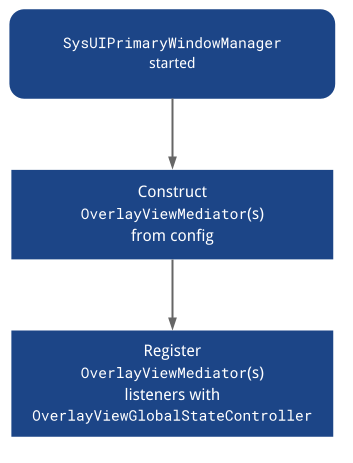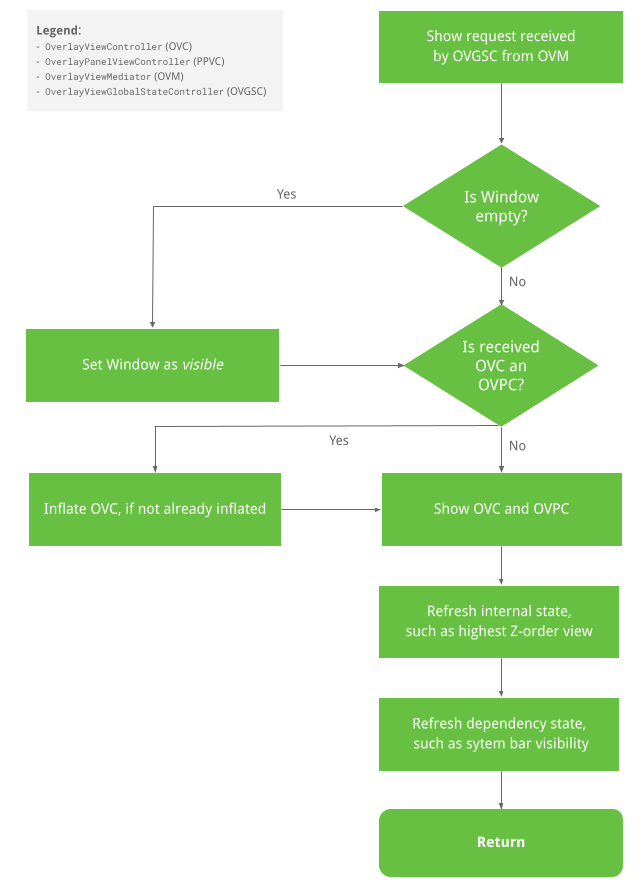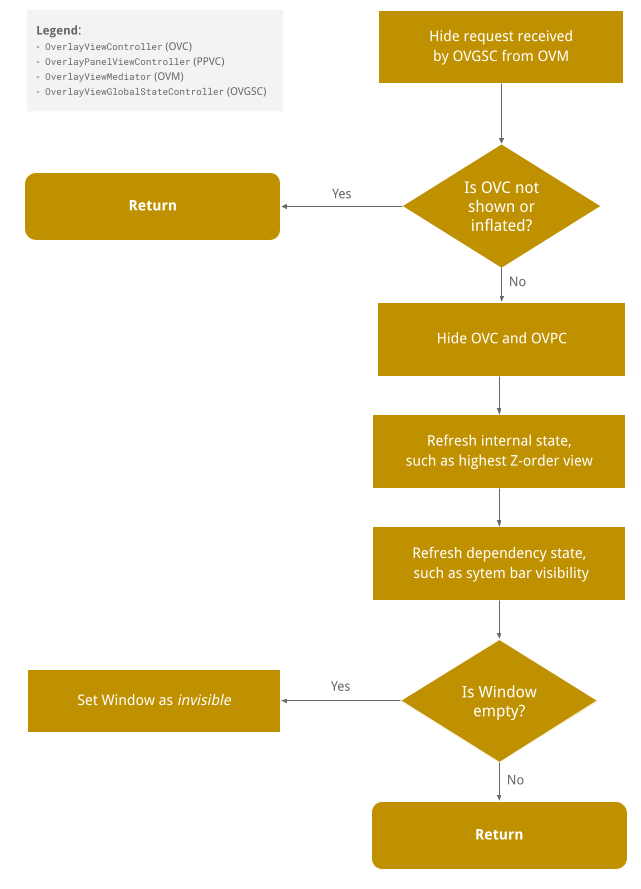El sistema de administración de SystemUIOverlayWindow te proporciona una forma de mostrar y administrar vistas en SystemUIOverlayWindow. Actualmente, esta ventana se usa para vistas, incluido el selector de usuarios de pantalla completa, el panel de notificaciones y el protector de pantalla. Esta página no hace lo siguiente:
- Crea restricciones sobre lo que el OEM puede agregar a la ventana.
- Te obliga a adoptar las abstracciones que se describen en esta página.
Descripción general
Puedes usar el sistema de administración de SystemUIOverlayWindow para mostrar vistas como el aviso legal, el selector de usuarios de pantalla completa, la cámara retrovisor, los controles de HVAC y el protector de pantalla. Esta ventana se encuentra fuera del espacio de la app y te brinda control sobre el orden en Z de la vista, los activadores de ocultación/revelación y las personalizaciones generales, como la posición, el tamaño, la transparencia y el color de la vista. Al mismo tiempo, no debes preocuparte por el estado de las barras del sistema ni por otros objetos de la IU del sistema que se deben ocultar o mostrar cuando se oculta o muestra su vista respectiva.
Para aprovechar SystemUIOverlayWindow, creas controladores de vista para tus mediadores de vista. Los mediadores se pasan al controlador de estado global de la ventana. Estos mediadores de vista realizan las siguientes acciones:
- Coordinar entre controladores de vista
- Aloja la lógica empresarial para los controladores de vista.
Controladores de vista (coordinados por mediadores de vista):
- Poseer su vista
- Crea seters a través de los cuales
OverlayViewsMediatorpueda adjuntar lógica empresarial. - Crea las animaciones de ocultación y revelación de su vista.
SystemUIOverlayWindowManager, un componente de SystemUI, funciona como un punto de entrada para inicializar y registrar mediadores con el controlador de estado global, mientras que el controlador de estado global se vincula a los controladores de vista de manera tal que los mediadores puedan llamar directamente a los controladores de vista para mostrar y ocultar vistas en la ventana.
OverlayViewController
OverlayViewController es responsable de la vista que se muestra en SystemUIOverlayWindow y controla cómo se oculta y se muestra. También permite adjuntar los objetos de escucha necesarios para que se puedan vincular a la lógica empresarial.
Firmas de métodos importantes
/**
* Owns a {@link View} that is present in SystemUIOverlayWindow.
*/
public class OverlayViewController {
/**
* Shows content of {@link OverlayViewController}.
*
* Should be used to show view externally and in particular by {@link OverlayViewMediator}.
*/
public final void start();
/**
* Hides content of {@link OverlayViewController}.
*
* Should be used to hide view externally and in particular by {@link OverlayViewMediator}.
*/
public final void stop();
/**
* Inflate layout owned by controller.
*/
public final void inflate(ViewGroup baseLayout);
/**
* Called once inflate finishes.
*/
protected void onFinishInflate();
/**
* Returns {@code true} if layout owned by controller has been inflated.
*/
public final boolean isInflated();
/**
* Subclasses should override this method to implement reveal animations and implement logic
* specific to when the layout owned by the controller is shown.
*
* Should only be overridden by Superclass but not called by any {@link OverlayViewMediator}.
*/
protected void showInternal();
/**
* Subclasses should override this method to implement conceal animations and implement logic
* specific to when the layout owned by the controller is hidden.
*
* Should only be overridden by Superclass but not called by any {@link OverlayViewMediator}.
*/
protected void hideInternal();
/**
* Provides access to layout owned by controller.
*/
protected final View getLayout();
/** Returns the {@link OverlayViewGlobalStateController}. */
protected final OverlayViewGlobalStateController getOverlayViewGlobalStateController();
/** Returns whether the view controlled by this controller is visible. */
public final boolean isVisible();
/**
* Returns the ID of the focus area that should receive focus when this view is the
* topmost view or {@link View#NO_ID} if there is no focus area.
*/
@IdRes
protected int getFocusAreaViewId();
/** Returns whether the view controlled by this controller has rotary focus. */
protected final boolean hasRotaryFocus();
/**
* Sets whether this view allows rotary focus. This should be set to {@code true} for the
* topmost layer in the overlay window and {@code false} for the others.
*/
public void setAllowRotaryFocus(boolean allowRotaryFocus);
/**
* Refreshes the rotary focus in this view if we are in rotary mode. If the view already has
* rotary focus, it leaves the focus alone. Returns {@code true} if a new view was focused.
*/
public boolean refreshRotaryFocusIfNeeded();
/**
* Returns {@code true} if heads up notifications should be displayed over this view.
*/
protected boolean shouldShowHUN();
/**
* Returns {@code true} if navigation bar insets should be displayed over this view. Has no
* effect if {@link #shouldFocusWindow} returns {@code false}.
*/
protected boolean shouldShowNavigationBarInsets();
/**
* Returns {@code true} if status bar insets should be displayed over this view. Has no
* effect if {@link #shouldFocusWindow} returns {@code false}.
*/
protected boolean shouldShowStatusBarInsets();
/**
* Returns {@code true} if this view should be hidden during the occluded state.
*/
protected boolean shouldShowWhenOccluded();
/**
* Returns {@code true} if the window should be focued when this view is visible. Note that
* returning {@code false} here means that {@link #shouldShowStatusBarInsets} and
* {@link #shouldShowNavigationBarInsets} will have no effect.
*/
protected boolean shouldFocusWindow();
/**
* Returns {@code true} if the window should use stable insets. Using stable insets means that
* even when system bars are temporarily not visible, inset from the system bars will still be
* applied.
*
* NOTE: When system bars are hidden in transient mode, insets from them will not be applied
* even when the system bars become visible. Setting the return value to {@true} here can
* prevent the OverlayView from overlapping with the system bars when that happens.
*/
protected boolean shouldUseStableInsets();
/**
* Returns the insets types to fit to the sysui overlay window when this
* {@link OverlayViewController} is in the foreground.
*/
@WindowInsets.Type.InsetsType
protected int getInsetTypesToFit();
/**
* Optionally returns the sides of enabled system bar insets to fit to the sysui overlay window
* when this {@link OverlayViewController} is in the foreground.
*
* For example, if the bottom and left system bars are enabled and this method returns
* WindowInsets.Side.LEFT, then the inset from the bottom system bar will be ignored.
*
* NOTE: By default, this method returns {@link #INVALID_INSET_SIDE}, so insets to fit are
* defined by {@link #getInsetTypesToFit()}, and not by this method, unless it is overridden
* by subclasses.
*
* NOTE: {@link #NO_INSET_SIDE} signifies no insets from any system bars will be honored. Each
* {@link OverlayViewController} can first take this value and add sides of the system bar
* insets to honor to it.
*
* NOTE: If getInsetSidesToFit is overridden to return {@link WindowInsets.Side}, it always
* takes precedence over {@link #getInsetTypesToFit()}. That is, the return value of {@link
* #getInsetTypesToFit()} will be ignored.
*/
@WindowInsets.Side.InsetsSide
protected int getInsetSidesToFit();
}OverlayPanelViewController
El controlador OverlayPanelViewController extiende OverlayViewController y proporciona capacidades adicionales de animación de arrastre a su superclase.
OverlayViewMediator
OverlayViewMediator aloja la lógica empresarial que revela o oculta varias instancias de OverlayViewController, por lo que, de alguna manera, también administra la coordinación entre los controladores de vista.
/** * Controls when to show and hide {@link OverlayViewController}(s). */ public interface OverlayViewMediator { /** * Register listeners that could use ContentVisibilityAdjuster to show/hide content. * * Note that we do not unregister listeners because SystemUI components are expected to live * for the lifecycle of the device. */ void registerListeners(); /** * Allows for post-inflation callbacks and listeners to be set inside required {@link * OverlayViewController}(s). */ void setupOverlayContentViewControllers(); }
SystemUIOverlayWindowManager
SystemUIOverlayWindowManager es responsable de ser el objeto SystemUI que funciona como punto de entrada para que el sistema de administración SystemUIOverlayWindow inicialice y registre instancias de OverlayViewMediator con OverlayViewGlobalStateController.

OverlayViewGlobalStateController
OverlayViewGlobalStateController recibe llamadas de instancias de OverlayViewController para revelarse o ocultarse. Por lo tanto, también contiene el estado de lo que se muestra o se oculta en SystemUIOverlayWindow.
A continuación, se ilustra el flujo de la vista de programa:

Oculta el flujo de vistas
A continuación, se ilustra el flujo de ocultación de la vista:

Firmas de métodos públicos
Las firmas de métodos públicos se codifican de la siguiente manera:
/**
* This controller is responsible for the following:
* <p><ul>
* <li>Holds the global state for SystemUIOverlayWindow.
* <li>Allows {@link SystemUIOverlayWindowManager} to register {@link OverlayViewMediator}(s).
* <li>Enables {@link OverlayViewController)(s) to reveal/conceal themselves while respecting the
* global state of SystemUIOverlayWindow.
* </ul>
*/
@SysUISingleton
public class OverlayViewGlobalStateController {
/**
* Register {@link OverlayViewMediator} to use in SystemUIOverlayWindow.
*/
public void registerMediator(OverlayViewMediator overlayViewMediator);
/**
* Show content in Overlay Window using {@link OverlayPanelViewController}.
*
* This calls {@link OverlayViewGlobalStateController#showView(OverlayViewController, Runnable)}
* where the runnable is nullified since the actual showing of the panel is handled by the
* controller itself.
*/
public void showView(OverlayPanelViewController panelViewController);
/**
* Show content in Overlay Window using {@link OverlayViewController}.
*/
public void showView(OverlayViewController viewController, @Nullable Runnable show);
/**
* Hide content in Overlay Window using {@link OverlayPanelViewController}.
*
* This calls {@link OverlayViewGlobalStateController#hideView(OverlayViewController, Runnable)}
* where the runnable is nullified since the actual hiding of the panel is handled by the
* controller itself.
*/
public void hideView(OverlayPanelViewController panelViewController);
/**
* Hide content in Overlay Window using {@link OverlayViewController}.
*/
public void hideView(OverlayViewController viewController, @Nullable Runnable hide);
/** Returns {@code true} is the window is visible. */
public boolean isWindowVisible();
/**
* Sets the {@link android.view.WindowManager.LayoutParams#FLAG_ALT_FOCUSABLE_IM} flag of the
* sysui overlay window.
*/
public void setWindowNeedsInput(boolean needsInput);
/** Returns {@code true} if the window is focusable. */
public boolean isWindowFocusable();
/** Sets the focusable flag of the sysui overlawy window. */
public void setWindowFocusable(boolean focusable);
/** Inflates the view controlled by the given view controller. */
public void inflateView(OverlayViewController viewController);
/**
* Return {@code true} if OverlayWindow is in a state where HUNs should be displayed above it.
*/
public boolean shouldShowHUN();
/**
* Set the OverlayViewWindow to be in occluded or unoccluded state. When OverlayViewWindow is
* occluded, all views mounted to it that are not configured to be shown during occlusion will
* be hidden.
*/
public void setOccluded(boolean occluded);
}Cómo agregar una vista a SysUIOverlayWindow
Para obtener más información, consulta el codelab.
Paso 1: Agrega un ViewStub a SysUIOverlayWindow
Agrega ViewStub al diseño de la ventana.
Paso 2: Crea un OverlayViewController
Usa el nuevo ViewStub para crear un nuevo OverlayViewController inyectable.
Paso 3: OverlayViewMediator
Crea un OverlayViewMediator nuevo que se pueda inyectar o usa uno existente (omite el paso 4) y registra objetos de escucha para ocultar o mostrar el OverlayViewController nuevo.
Paso 4: Configura el nuevo OverlayViewMediator
Agrega tu OverlayViewMediator nuevo a
OverlayWindowModule y a config_carSystemUIOverlayViewsMediator.
Advertencias
Cuando SysUIPrimaryWindow cubre toda la pantalla, los elementos debajo de la ventana no registran eventos táctiles. Por lo tanto, cuando la ventana cubre toda la pantalla, pero su contenido deja un espacio negativo, puedes desenfocar ese espacio y adjuntar objetos de escucha a ese espacio para descartar el contenido de la ventana.

